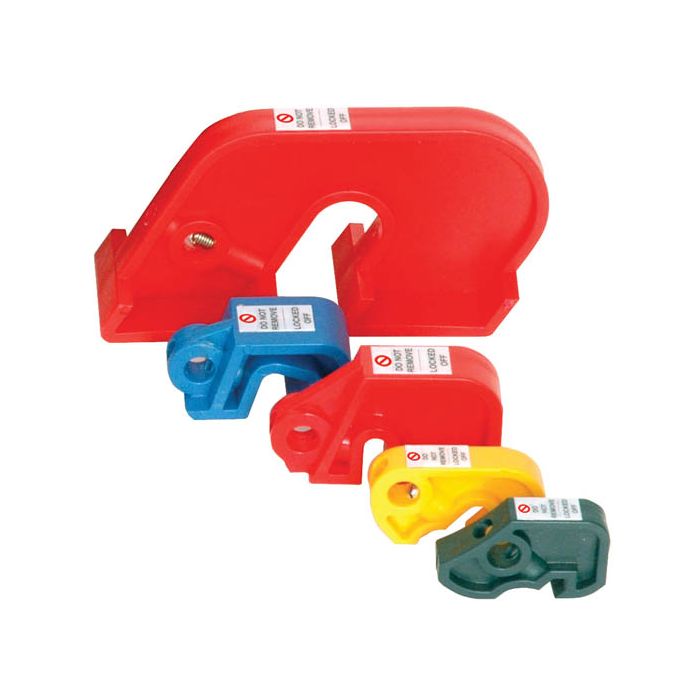Martindale LOKMCB MCB Isolation Lock Kit
- Compatible with most circuit breakers
- One size for MCB's
- Good practice for Health and Safety
- Universal Fit
-
-
Information on the calibration of newly purchased equipment and what it means to you.
Calibration and its certification comes in varying forms on new equipment and in this section, we will break it down into the three areas that we use to classify calibration state at the point of purchase.
Manufacturers Calibration Certificate
This is a calibration certificate offered by the manufacturer supplied with the tester. This is also known as an end-of-line certificate or manufacturer’s certificate. These certificates vary depending on the manufacturer and product. They will not have your company's name on them and don’t always show proven test results.
Where applicable we will include the following statement relating to the item/s on the products page under the heading *Important Calibration Information.
This instrument comes complete with the manufacturer's calibration certificate. Please be aware that these certificates are generic and may also be time-lapsed.
If you would prefer a personalised full traceable calibration certificate applied to the equipment before dispatch, then please select this option from the drop-down menu above, an additional calibration charge will apply.Manufacturers Certificate of Conformity
A manufacturer's certificate of conformity is not a calibration certificate. It is merely a statement that the equipment has been produced to operate within its intended application, it has no traceable certificate or constitutes any defined results for accuracy before leaving the manufacturing process.
Where applicable we will include the following statement relating to the item/s on the products page under the heading *Important Calibration Information.
This instrument comes with a ‘manufacturer's certificate of conformity’. It is important to understand that this does NOT constitute a ‘calibration certificate’. A certificate of conformity merely states that the equipment has been designed and produced to meet the requirements of its intended application.
Where calibration of an instrument is possible we will offer this as a separately purchasable item and may be selected from the drop-down box above. You will be sent a full traceable calibration certificate produced in our laboratory and applied with your details as required.Personalised traceable calibration certificate from isswww
This is a calibration certificate created by us at ISS. This certificate is fully traceable to national and international standards. The certificate will show your company's details, tester information, proven test results and the equipment used to carry out the test. Nearly 90% of all calibrations we do are done in-house in one of our many fully equipped laboratories. You can add this service to your order on the product page before you checkout.
Where applicable we will include the following statement relating to the item/s on the products page under the heading *Important Calibration Information.
We are on occasion able to offer FREE calibration on certain products at their point of sale (newly purchased equipment only) please look out for the following badge on the product's page to take advantage of this free offer.

-
-
Martindale LOKMCB MCB Isolation Lock Kit
These locks are for use with MCBs on domestic and industrial distribution boards for isolation purposes.
Set of 5 MARLOKMCB
Also available as individual part
green - MARLOK1
yellow - MARLOK2
blue - MARLOK3
small red - MARLOK 4
large red - MARLOK5
|
||
 |
||
|
Safe isolation procedures are in place to ensure that workers on site are not exposed to danger when working on or near live electrical systems. There are many reports where these procedures have not been followed correctly and sadly this has resulted in needless loss of life. One such report involves a large UK electrical contractor, where a circuit had been labelled as not in use. The engineer working on the system did not have the necessary equipment to prove the system was dead. As a result he came into contact with a live conductor and was killed. The company in question was found guilty of failing to provide the right equipment and fined £300,000. The Electrical Safety Council, now renamed as Electrical Safety First, has produced a guidance document that covers the best practice for safe isolation and part of this guidance covers the test equipment that should be used. Using the right equipment is one of the most important parts of the procedure, as failure to do so can result in a circuit remaining live, resulting in injury or death. With a wide range of voltage detectors and indicators available, we look at what the requirements are and the reasons why some equipment, such as multimeters, should not be used for this process. What equipment is required for safe isolation? The Electrical Safety First Guidance states that "…The point of isolation should be locked off using a unique key or combination retained by the person carrying out the work or the appointed person, and a caution notice attached to the point of isolation. Where more than one operative is working on circuits supplied from an isolated distribution board, a multi-lock hasp can be used to prevent operation…" Locking off kits are available to ensure you have all the necessary equipment to lock out the circuit being worked on. There are a number of kits available on the market, however a basic kit should include the following:
Note that the padlock must have a unique key or combination. This should be held by the person carrying out the work to prevent anyone else from removing the lock and inadvertently activating the circuit. Most combination padlocks have a default setting of zeroes, so if you are using this type of lock, ensure the combination has been changed prior to use. Once the breaker has been locked off correctly, a warning tag should be attached to clearly identify that the circuit has been locked off and is currently being worked on. Locking off the circuit correctly is just one part of the procedure. Before carrying out any work on the circuit, you should also verify that the circuit is definitely dead before proceeding. Circuits are frequently mis-labelled so there is no certainty that the correct circuit is locked off. In order to do this, you should use a dedicated voltage indicator and a proving unit. The guidance makes a number of points in regard to use of voltage indicators to prove dead, some of the key ones are: "Following isolation of equipment or circuits and before starting work it should be proved that the parts to work on, and those nearby, are dead. So, it is not enough to simply lock off the breaker and assume that the circuit is now dead. There are recorded instances where neutrals are "borrowed" and while this is not permitted by BS7671, it is unfortunately not uncommon. In this instance, although a particular circuit may be locked off, the neutral conductor can become live, if an energised load on another circuit is connected to it. What is the correct equipment for proving dead? As Electrical Safety First states, you should use a dedicated voltage indicator and a proving unit when carrying out this procedure. The list of suitable equipment includes test lamps, such as the Drummond MTL10 or MTL20, or a two-pole voltage detector, such as the Martindale VI13800 or VI-15000. It is important to note that the voltage indicator MUST be able to work without the need for a battery, if you are using a device that needs a battery in order to work and the battery is flat, then you will not be able to prove if the circuit is dead or not! The procedure for proving dead is to take your voltage indicator and check it against a known source, such as a proving unit, then test the circuit, then test the voltage indicator against the known source again to prove the tester has not failed during testing. Whilst you can use a known live source to test your voltage indicator, we recommend using a dedicated proving unit. The reason is that the known live source will only light some of the LEDs on the tester, whereas a proving unit will ensure that all LEDs on all ranges are working, again safeguarding against incorrect readings due to a blown LED. In addition, there may not be a known live source near the area you are working, so by having a proving unit with you, you’ll never have this problem. Voltage indicators should be proved using a known source both before and after testing the circuit. Why can’t I use a Multimeter or non-contact voltage detector to prove dead? Firstly, the use of Multimeters or non-contact voltage detectors is advised against in the HSE guidance and the use of these has resulted in accidents in the past. The reason why a Multimeter is not suitable is that it is all too easy to select the wrong range. In addition the Multimeter relies on battery power to function, thus there is a great margin for error in making a false “dead” reading on a live circuit. Non-contact voltage detectors also require a battery in order to work, however they are typically sensitive to other signals, such as static electricity. In addition it is impossible to prove this type of device is working correctly with a standard proving unit, a dedicated proving device would be required. Whilst these units can be used to detect live cables, they cannot reliably be used to prove dead. In conclusion, this article has briefly touched on safe isolation procedures, further information can be found on the HSE website and the full guidance note is available online. The key point here is that whilst there is a cost involved in the purchase of new equipment, is it worth risking a life, possibly yours, for the sake of a few pounds? This article has quoted from the Guidance on the management of electrical safety and safe isolation procedures for low voltage installations (BestPracticeGuide Issue 3), produced by Electrical Safety First. Direct quotes are marked within " " and in italic. Martindale voltage indicators, proving units and lock off kits are available from ISSWWW.CO.UK
|
||
| Author: Steve Dunning © Martindale Electric Co Ltd - 2016 - All Rights Reserved |
| Key Features | Compatible with most circuit breakers, One size for MCB's, Good practice for Health and Safety, Universal Fit |
|---|---|
| Product Stock Status | Next Day Delivery (subject to availability) |
| Manufacturer | Martindale |
Updated January 2024
Please note, our cut-off time is 2:00pm
Orders requiring calibration
Whilst we take the greatest care to get all orders dispatched and delivered to you in the stated time frame, orders received PM and requiring calibration may on occasion miss dispatch that day, according to the complexity of the calibration.Be assured they will ship on the next dispatch this in most cases should not add more than 24 hours to your delivery.
Bank/Public Holidays
Predicted delivery times are based on regular trading days Monday to Friday. Public holidays, bank holidays and weekends are outside the usual scopeof our dispatch and subject to activities/holidays of our carriers and therefore may incur additional days lead time to your order.
*UK Mainland (Revised March 2021)
| Service | Price |
| Standard FREE 2-3 Day Courier Delivery – UK Mainland only - Zones A & B - Order value OVER £75.00 ex VAT | FREE |
| Standard FREE 2-3 Day Courier Delivery – UK Mainland only - Zones A & B - Order value UNDER £75.00 ex VAT | £4.95 |
| Next WORKING Day (excludes Saturdays, Sundays and public holidays) – UK Mainland only - Zones A & B - ANY order value - Order by 2:00pm | £7.75 |
| Saturday ANYTIME Delivery - Order by 2:00pm | £9.95 |

Delivery Surcharges
Because of the high cost of carriage, we regretfully need to apply a surcharge on all deliveries made in the following regions:
- Zones A & B - Mainland delivery rates apply.
- Zone C - Scottish Highlands (Charges are calculated at the checkout).
- Zone D - Outer Hebrides, Orkney Isles, Shetland Isles, Isle of Man, Scilly Isles, and Channel Islands (Charges are calculated at the checkout).
- Zone E - Northern Ireland (Charges are calculated at the checkout).
- Zone F - Republic of Ireland (Charges are calculated at the checkout).
Offshore Services
All offshore deliveries are a 3-4 day service as standard. This includes Channel Islands, Northern & Southern Ireland, Scottish Islands, Isle of Man and the Scilly Isles.
International delivery
International delivery charges are automatically added to your order at the checkout. For any questions regarding international deliveries please contact us at sales@isswww.co.uk
Export
All export inquiries should be directed to the export division before placement of order.
If no shipping option is available to your selected country please call us FREE on 0800 0224 060 to discuss your requirements.
All stated prices are subject to VAT at the current rate where applicable.
E&OA



